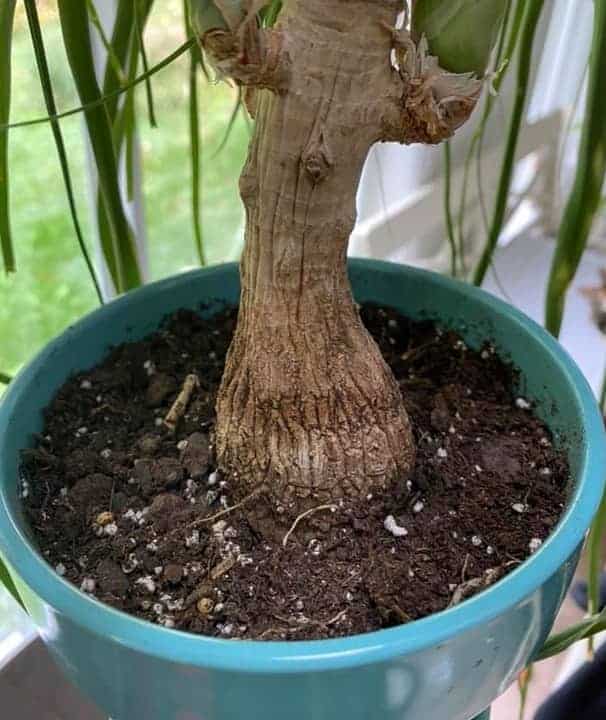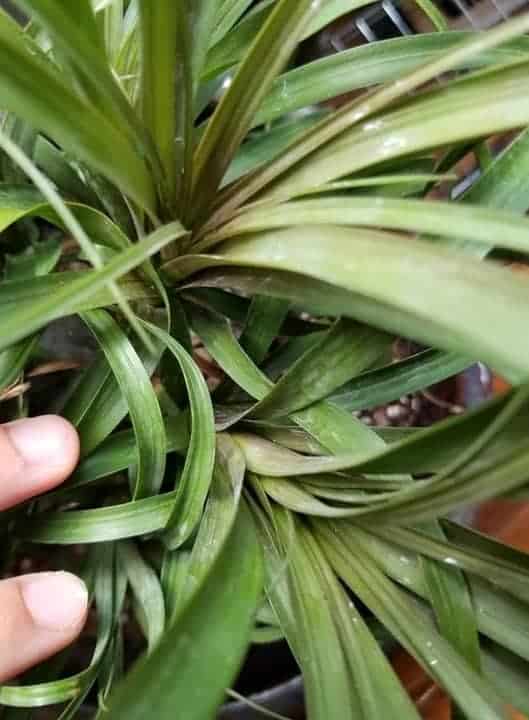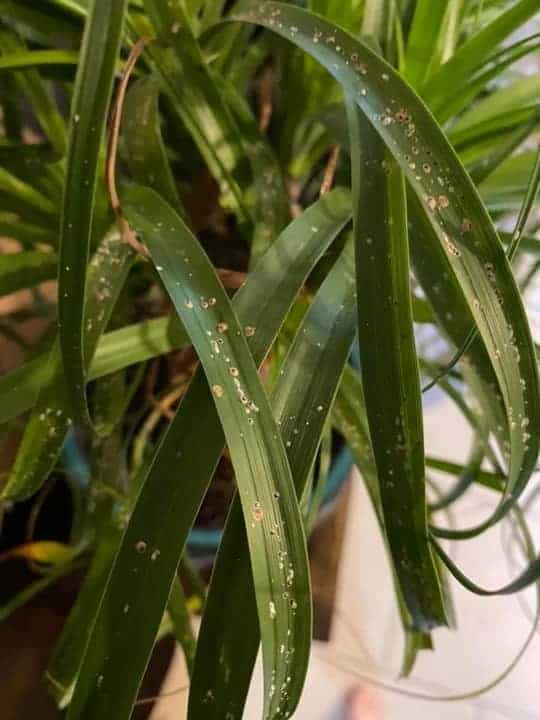Often called the bottle tree, your Ponytail Palm is not a palm at all, and this may well be why your plant has started to look unhappy.
Overwatering is the most common reason for ponytail palms dying. The Ponytail Palm is a succulent, and misunderstanding can lead to this plant being overwatered and developing root rot, which is the most common cause of its demise.
The good news is that even if overwatering is why your Ponytail Palm looks so sad, the situation can be turned around if decisive action is taken.
Contents
- Why Is My Ponytail Palm Dying?
- How to Revive Your Dying Ponytail Palm
- Propagate To Save Dying Ponytail Palm
- Final Words
Why Is My Ponytail Palm Dying?

Like all plants, there can be many causes that health issues arise.
We will look at these individually, but it is essential to know that this plant needs very little water and that overwatering is the most common issue you will likely face.
Overwatering
Signs: The most apparent sign of overwatering will be the leaves starting to turn yellow and droop. The soil will remain wet, and mold growing on it.
Solution: To avoid this problem, establish a good watering routine as soon as you acquire your plant.
These plants need to dry out between each watering, at which point you can soak them and then allow all excess water to drain away.
You will probably not need to water again for as long as two weeks to a month at that stage. In the winter, you will hardly have water at all.
To assess when to water, poke your finger into the potting soil up to your second knuckle. If everything you feel is dry, you know it is time to water again.
Always ensure that the water you provide drains away entirely and that the plant base does not stand in a saucer of water.
Underwatering
Signs: If your Ponytail Palm is under-watered, it will display very different signs to those of overwatering.
First, it will droop and look sorry for itself. After that, leaves will turn brown and become crisp and hard.
Solution: To rectify this problem, you must soak the soil by standing the pot in a water basin for forty-five minutes.
The soil should absorb moisture through the drainage hole in the bottom of the pot, and once that process has taken place, the plant can be removed from the water and excess water allowed to drain away.
Ponytail Palm Trunk Soft

Signs: If the trunk of your ponytail palm becomes soft and spongy or you see wrinkles beginning to appear, your plant is seriously overwatered.
What is happening is that moisture retained within the trunk is starting to break down the fibers.
This is a severe condition and needs to be addressed immediately. Remember that this is similar to a succulent, and the plant stores moisture in that thick stem.
Solutions: allow the potting soil t to dry out completely. To accelerate this process, you may need to remove the plant from its pot and stand it on some newspaper so the root ball can dry out.
Repot it into new potting soil and don’t water again until the soil dries.
Palm Crown Rot

Signs: If the base of the leaves starts to go brown and soggy, chances are your ponytail palm has crown rot. As is often the case with this plant, the cause originates from a watering issue; in this case, it is overwatering.
Solution: What has happened here is that the overwatering issues have started to manifest themselves in the plant’s crown.
The crown has become mushy, and the leaves will start to fall. Allow the plant to dry out and recover slowly but don’t be tempted to feed or repot it.
Eventually, new growth will appear, at which stage you can continue with your proper watering regime.
Leaves Falling off
Signs: Leaves falling can be a slightly confusing symptom because this can occur with both overwatering and underwatering. The way to tell the difference will be to feel the soil.
If it is damp and the leaves are falling,, it is sure to be an overwatering problem. If it is dry, then you may be underwatering.
Solution: First, you will need to assess whether the cause is over or underwatering. Once you are sure where the problem lies, you can respond accordingly.
Give the plant a good soak in its underwatered, and allow it to dry out if it is overwatered.
Trunk Splitting
Signs: There is nothing ambiguous about this one. Cracks begin to appear in the trunk of your Ponytail Palm.
Solution: The vertical cracks you see result from too much water. As the plant attempts to deal with the excess water it is now storing in its trunk, these cracks start to appear.
If you reduce the watering, they will start to heal but will not go away. After that, just stick to a suitable watering regime.
Poor Drainage
Signs: The plant’s leaves first begin to droop, and then they start to turn yellow and fall.
These are the classic symptoms of overwatering, but it could simply be that the potting soil is not draining effectively, even though you may be watering correctly.
Solution: Firstly, it is imperative to ensure that the container your Ponytail Palm is planted in allows excess water to drain away freely.
There must be a hole in the base of the pot, which will need to be at least large enough to get your finger into it.
Another reason for poor drainage is standing the pot in a saucer filled with water.
Allow all the water to drain from the pot before replacing it in its saucer, as excess water slows the drainage process.
Finally, the soil in which the pot is planted needs to be free draining. Many potting soils are designed to retain moisture, but the Ponytail Palm stores water in its trunk.
You should plant into a cactus mix or include fifty percent perlite into your potting mix so that the soil drains quickly.
Not Enough Light
Signs: Slow growth and jaundiced-looking leaves.
Solution: Your Ponytail Palm is very tolerant, so light rarely becomes an issue. Ideally, it prefers bright filtered light, but this palm is so forgiving that it will tolerate relatively low light conditions.
Where problems result from low lighting, they are generally in conjunction with watering issues.
If you get the watering right and ensure that the plant does at least get some indirect light, you shouldn’t have a problem.
If you live in a US hardiness zone of around 11, you may decide to keep your Ponytail Palm outdoors during summer.
This is fine but allows the plant to adapt to the brighter conditions gradually over a period of ten days to a fortnight.
Pathogenic Infection
Signs: One of the most apparent signs of a pathogenic infection is black or dark brown spots appearing on the leaves and, occasionally, on the trunk of your plant.
These later become soggy and can lead to the death of the plant if not dealt with.
Solutions: The three most likely ways that this pathogen has attacked your plant are from spores that were resident in the soil, on the pot, or were already present in the root system.
Never be tempted to reuse old potting soil, no matter how healthy it looks. Always wash your pots out with bleach before reusing them.
If the pathogen was already in the root system when you got it, there is little you could have done other than to closely examine the plant for signs of poor health before you purchased it.
If your Ponytail Palm is showing signs of being infected by pathogens, repot into lean potting soil.
Examine the roots while it is out of the pot and cut away any tainted material.
Incorrect pH
Signs: The pH of the soil is a factor that is sometimes overlooked when it comes to house plant health.
But it is something that can lead to the gradual deterioration of the overall health of your plant. Look out for these signs, chlorosis of the leaves and slow or stunted growth.
Solution: It is easy to mistake the signs here for either a lack of nutrients or damaged roots, usually from overwatering. pH problems are different, and the only way to be sure that this is what you are facing is to do a pH test.
pH testing kits are available at most garden centers and are easy to use. The pH required by your Ponytail Palm is between 6.5 and 7.5.
While there are ways of tinkering with the pH, it is just not worth the effort with a house plant. Simply repot into soil that matches the requirement of your plant.
Incorrect Temperature
Signs: These plants are very forgiving regarding temperature but hate to fall below 45°F (7°C).
Once the temperature goes below this, your plant will become stressed. Leaves will droop and then start to drop.
Solution: Some people place their plants outdoors in the summer, mainly when they forget to bring them in as the colder weather draws closer that this problem starts.
If the plant is not being placed outdoors and the temperature is falling too low, then you are going to need to think about additional heating, but this is unusual in a typical house where we tend to keep temperatures higher.
The Ponytail Palm’s ideal temperature range falls between 50°F and 80°F (10°c – 27°C).
If you are worried that the temperature in the home is outside of this range, then purchase a cheap home thermometer to find the temperature range and use central heating to keep the temperature within that spectrum.
Pest Infestation Can Cause Severe Damage to Ponytail Health
Because the Ponytail is pretty robust, you are unlikely to find pets becoming a significant issue.
That said, there are three pests that indoor gardeners are most commonly at war with, and there is a chance you will come across one or more of these.
Mealybug
Small white fluffy dots that often inhabit the leaf joints and secluded crevices from where they can suck the sap of your plant
Solution: These pests, like others, only damage the plant when their numbers are high. This means the best defense is to examine the plant closed on a regular basis so that you can deal with them before they get established.
Wiping the leaves with neem oil or vegetable soap will get rid of these pests and keep the plant looking healthy.
Scale insects

Another sap-sucking pest that relies on a disguise, these insects hide beneath a cuticle of hard tissue that looks like tiny brown scabs.
You must look carefully at the leaves’ base and undersides to spot them.
Solution: In small numbers, they can be scratched off with your fingernail or the back of the blade of a knife. If they have become more established, dab them with cotton wool dipped in neem oil.
As with mealybugs, they will be kept at bay by regularly wiping the plant with neem oil or a vegetable-based soap.
Spider Mites
These little guys are almost invisible to the naked eye. The first sign you will probably have as to their presence is likely to be discoloration of the base of the leaves where they have sucked away the chlorophyll. There may be delicate webs down there as well.
Solution: These little pests mainly manifest themselves when conditions are too dry. They don’t like getting wet, so simply taking your plant outside and spraying them off with a blast of water will often get rid of them.
Low Humidity
Signs: This problem often goes hand in hand with too little water, and you can expect similar symptoms to those of an underwatered plant. It is pretty uncommon with the Ponytail Palm.
Solution: Because this plant is so hardy, it is unlikely that you will need to go to great extremes, such as purchasing a humidifier.
Instead, here are a couple of easy-to-activate methods of raising the humidity near your plant.
Placing the Ponytail Palm in the vicinity of other house plants will automatically increase humidity as their combined transpiration causes a small microclimate.
If that isn’t possible, fill the plant saucer with pebbles and cover them with water. As the water evaporates, the humidity around your palm will go up.
Don’t let the water cover the base of the pot, as insufficient drainage is a far greater risk to the health of the Ponytail Palm.
Watering When Dormant
Signs: These plants don’t like to be too wet, especially during the cooler months when the plant is dormant.
If you water too often over the winter, you will quickly create overwatering issues with all the signs we have already looked at.
Solution: Outside of spring and summer, cut back watering to half of what you have been providing during the growing period.
Depending on your conditions, you should have only been watering every three weeks to a month. Now you will only need to water once every six weeks or so.
Root Bound Plants

Signs: The plant grows more slowly, and water runs away more quickly.
Solution: This isn’t a massive problem with the Ponytail Palm. You can keep this plant in the same pot for up to three years, and it won’t even blink.
If you are sure you need to repot, use a pot just one or two inches larger than the original, and remember to use free-draining potting soil.
How to Revive Your Dying Ponytail Palm
I trust that you have now come to see that the biggest threat to this plant by far is overwatering which can soon result in root rot.
Root rot kills off many smaller roots responsible for moisture uptake, so the plant soon finds itself lacking in nutrients.
If you have overwatered your Ponytail Palm and it does not show signs of recovering when you stop giving it water, then you should repot it.
Tip the palm from its pot and lay the root ball on a sheet of newspaper until it dries out.
Examine the root ball closely and cut away any material that looks brown, soggy, or rotten. After that, dust the roots with a fungicide to help prevent pathogenic infection.
You can repot using a cactus mix or home-improved potting mixture to provide maximum drainage at this stage.
Don’t water the plant for a while and let it settle into its new home. The potting mix will have been slightly damp, and remember that these pants have sore moisture in their trunks, so err towards too dry rather than too wet.
Propagate To Save Dying Ponytail Palm

If the plant has root rot and it looks like you might lose it altogether, look for some of these pups and start them off so that all is not lost.
It’s always nice to produce more of your own plants. Although this plant does flower and occasionally set seed, don’t bother going down this route. It takes forever, and sometimes life is just too short.
Instead, wait until the plant creates tiny offsets known as pups. These little pups can be gently broken off the parent plant and then grown in small pots to create perfect replicas of the parent plant.
Final Words
It is an easy to look after and advantageous house plant if you just remember not to overwater it.
Although not a true succulent, its water storage capacity and hatred of wet soil mean that it can be treated as one for the best results.






